Fighting for partners can help animals adapt better when their living environment becomes harsh
Millions of organisms all over the planet are day by day, every hour fighting with negative effects caused by human-induced climate change.
Climate change causes the Earth to warm up, while catalyzing the familiar weather patterns. On the ground, natural disasters become more and more unusual, fierce, and unpredictable. While under the ocean, the habitat of marine species is also being seriously threatened while sea water is more and more acidic. And above all, the previously less disturbing living environment of animals is now gradually changing and rapidly degrading due to human activities. After all, extinction is an inevitable consequence.
- Unexpected benefits of plants and animals: Lighting, explosive detection, disaster prediction and many other great applications
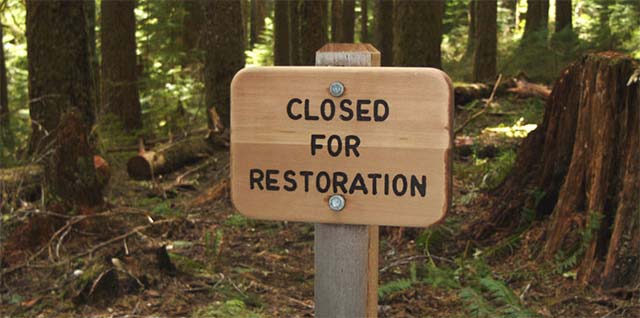 The habitat of animals is increasingly seriously threatened by human impact
The habitat of animals is increasingly seriously threatened by human impact
The choice of mating and adaptability of animals
- The reality of the relationship between negative changes from the environment and species
- Negative changes from habitat and adaptability of species
- Field research on beetles and interesting findings
The reality of the relationship between negative changes from the environment and species
The UN's planetary biodiversity assessment report found that nearly 1 million species of plants and animals on Earth are facing extinction in the near future. resulting from human activities for decades. In particular, the insects are disappearing on the earth at a record speed. According to a study, as many as 40% of the insects that have appeared in the world today have disappeared or constantly declined in number rapidly.
- Sea salt rock 2 billion years old shows an increase in oxygen in the ancient atmosphere
 About 40% of the insects that have appeared in the world today have disappeared
About 40% of the insects that have appeared in the world today have disappeared
The disappearance of insects will also entail tremendous disasters for many other species, including plants and especially insects that feed on insects, or more broadly, the entire food chain. It is an extremely dangerous domino effect. In about 50 years, about 1,700 amphibian, bird and mammal species will face a higher risk of extinction than expected because their natural habitat is shrinking rapidly. More specifically, terrestrial animals will lose between 30% and 50% of their current habitat range due to excessive land use by humans.
If we want to better understand how negative changes related to climate change and habitats affect animals across the planet, we need to know more about biological characteristics first. of them, which can determine the specific adaptability and survival of each species after these negative changes.
- The best fathers in the natural world that you may not know
Negative changes from habitat and adaptability of species
Recently, a research team from Queen Mary University, London, led by renowned biologist Rob Knell conducted a scientific study of the system as well as the mating characteristics of the animals. How things play an important role in helping them adapt to negative impacts from their environment. The results show that species in which males compete for more intense partnerships are more likely to survive harmful changes from their habitat. This may sound unrelated, but the reality is extremely reasonable.
In many species, males try to attract females with specific signals that show their strength or charm, such as the cries, the color of the coat, or some of the most impressive parts of the body. a long tail or a big crest. However, most of the species, both on land and in water, will seek exclusive access and mating with their children through 'one-on-one' battles with other males with weapons like horns, antlers or sharp claws.
- 17 signs that the 6th great extinction - the nightmare of humanity is about to sweep through the earth
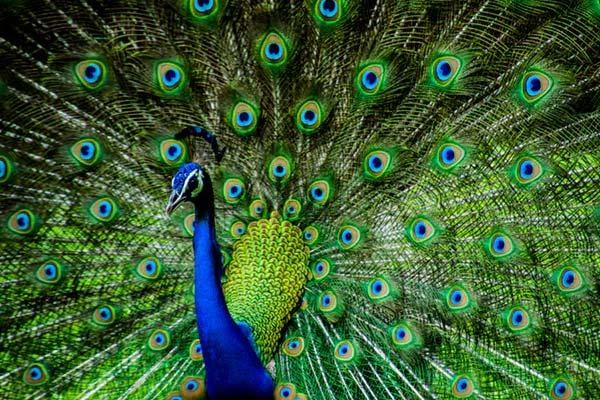 The eye-catching appearance helps the male to win the hearts of the children, but it is also this characteristic that makes them vulnerable to predators.
The eye-catching appearance helps the male to win the hearts of the children, but it is also this characteristic that makes them vulnerable to predators.
These wars full of risks contribute an important part in promoting the evolution of living species, namely in a process called 'mating choice'. The most compelling, healthy or most ferocious partners will have their superior genomic transmission opportunities for the next generation, thereby generating more individuals with superior characteristics, through which the race will improve.
There are many reasons to deduce that the fierce competition in mating of organisms can affect their resilience as well as maintain their quantity for negative changes from the environment. First, noticeable characteristic signals and self-defense 'weapons' such as sharp teeth, sturdy horns or powerful muscular muscles often develop comprehensively in species that compete in mating is extremely intense. In other words, it is a trade-off that they must accept if they want to maintain the race.
Why say it is a trade-off? For a simple example, when a male bird wears beautiful, brilliant fur, he will have more opportunities to reach his children, however, this same coat makes them more likely to be noticed by enemies, even causing them to lose their lives. Or like when male antelopes come to mating season, they will become extremely aggressive. A pair of bulky, strong horns made them entangled (even stuck in the bushes). Ordinary days would now become extremely high damage weapons, which could take enemy networks at any time. Thus, it can be concluded that species with a strong mating selection process will be less able to cope with the negative change from the environment due to the disadvantages that they must accept in exchange for advantages. in mating competition.
- Natural disasters can kill insects and invertebrates
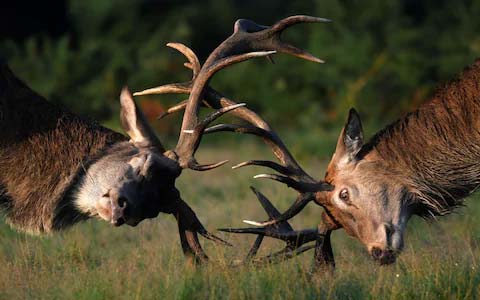 The pair of everyday entangled horns of deer will be an effective weapon to help them win the battle for partners
The pair of everyday entangled horns of deer will be an effective weapon to help them win the battle for partners
On the other hand, strong competition between males to win partners means that only a few males are particularly brave, healthy and full of life can win and become the father of most Next generation in herd. If the habitat changes in a bad way, only the genetically best male with the new environment is likely to be in the best physical condition. If these males ended as winners in the competition to gain the right to mate, well, the genome with their excellent adaptability will be passed on to the next generation. Thus, a strong mating choice can make the animal population adapt more quickly to the new environment, making them more resilient in the face of negative change.
After these two conclusions, we see a small contradiction. The moderate mating selection process can limit the ability of animals to cope with the negative change due to the disadvantages they have to trade, while still being able to help them. The following system possesses the ability to better adapt to all changes, so which process is more important, more strongly influences the survival of animals?
A series of other studies conducted in the laboratory have constantly discovered that a strong mating choice helps to reduce the impact on animals when the environment changes from optimal to carving. Harsher. However, animal studies in this area are often not found or cannot show the effect of mating choice or vice versa.
- How are people using plastic to destroy nature?
One possible reason for this contradiction is that field studies often focus on relatively small animal populations. It is possible that the effects of mating choices on maintaining the number of individuals vary according to the size of the population.
Very small populations living in a given location may not possess the full range of genes needed to create individuals that are able to adapt very well to their particular habitat. In this case, the disadvantages that must be exchanged for the choice of mate as mentioned above can make them more extinct. Meanwhile, in the case of a large population, which is more likely to possess genetic diversity, the type of gene needed will also be more formidable. At this time, the strong mating choice will help filter out males with the best genome, thereby helping the next generation to be more adaptable when living conditions become worse.
What is needed here is a field study of the choice of mating and the rate of good genome retention in larger populations. With that in mind, the research team from Queen Mary University continues to conduct another study, published in Ecology Letters, regarding how the beetle (dung beetle) responds to changes. negative from their habitat in the Sabah tropical rainforest in Malaysia Borneo.
- The surprising relationship between climate change - birth rate and consequences
Field research on beetles and interesting findings
Beetles are one of the most interesting animals in the natural world for many reasons, the most prominent of which is the variety in their sex life. Although they are insects, male beetles will fight fairly to gain the right to mate as many terrestrial mammals.
In some species of beetles with a strong mating selection process, males often possess very large and strong horns, which are used to fight other males. While in beetles that have less choice of mating, male horns are very small or even without horns. In addition, they are also less aggressive in pursuing their partners.
- A global temperature increase of only half a degree may cause 5 million people to lose their homes
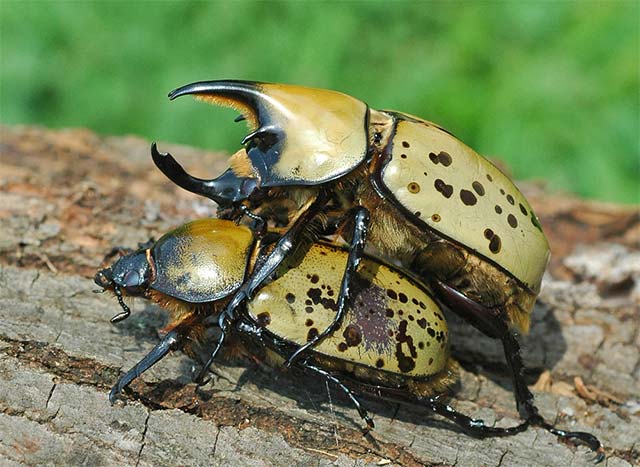 Beetles have a very diverse sex life in the insect world
Beetles have a very diverse sex life in the insect world
Through a large-scale study called SAFE Project, the research team followed 34 different beetle species found in an old tropical rainforest that still ensures pristine , almost unaffected by the negative impacts of climate change. Next, scientists have considered how they survive in a slightly invasive forest, then gradually increase, and so on to the final environment in the oil-producing plantations - where primeval forests are wiped out to serve human economic activity.
The team found that horned beetles possessed more survivability in all of these cases. Notably, all 11 species remaining in the oilfield - the most negatively impacted environment - have horns.
From the above results, scientists continue to make comparisons between relatively small horned beetle species compared to other species that carry larger horns to see if the size of the horn will impact. how to adapt to them. As a result, larger horned beetle species are not only able to survive in disturbed environments, but they also tend to maintain population size (the number of later generation individuals). bigger.
This tells us that at least in some specific cases, we should think more about the choice of mating as well as other biological aspects of animals if we want to predict or manage the individual size of the animal when they face changes from the environment.
- Coral reefs are threatened by ocean acidification, which can disintegrate before 2100
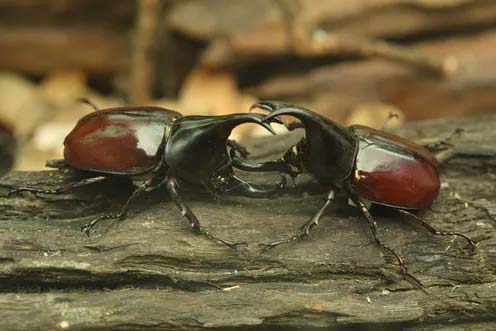 Although they are insects, beetles will fight fairly to gain the right to mate as many terrestrial mammals.
Although they are insects, beetles will fight fairly to gain the right to mate as many terrestrial mammals.
The choice of mating is a common and powerful characteristic, promoting evolution in the animal kingdom and has been observed in depth by biologists who specialize in behavioral and evolutionary research. Perhaps now, ecologists and wildlife management experts should take the time to pay more attention to this aspect to come up with more effective conservation policies.
Above all, each person has to be self-conscious, join hands to protect the common environment on Earth. Without the sense of protecting nature, we are killing our own future. It is a cruelty, not only for all creatures on the planet, but also for our own children and grandchildren!
You should read it
- 'Iron Man' Robert Downey Jr. Founder of the Alliance to clean the earth with AI and robots
- What is left of Asia if the whole ice on Earth melts?
- Why do beautiful natural photos make people feel happy?
- Global warming can weaken wind power, a study predicts
- Found shelter for corals threatened by global warming
- Why shouldn't you disable the System Integrity Protection feature on the Mac?
- What is the most devastating natural disaster that the earth has experienced?
- 4 simple ways to protect your eyes when working long in front of electronic devices
May be interested
- How to protect outdoor spaces from harsh weather
 rain, and even harsh sunlight, can damage outdoor decor and infrastructure, so add weatherproofing to your outdoor living plans.
rain, and even harsh sunlight, can damage outdoor decor and infrastructure, so add weatherproofing to your outdoor living plans. - Top 10 things you didn't know about the Nether in Minecraft
 the harsh world of minecraft does not stop at the desert island you are trying to adapt to, but also has the nether - considered hell.
the harsh world of minecraft does not stop at the desert island you are trying to adapt to, but also has the nether - considered hell. - How many animals have ever existed on Earth?
 there are about 8 billion people living in the world, only a small fraction of the number of people who have ever existed, and this number is still very small compared to the number of animals that have ever lived on earth.
there are about 8 billion people living in the world, only a small fraction of the number of people who have ever existed, and this number is still very small compared to the number of animals that have ever lived on earth. - Interesting things about the eggs of animals
 in the world, there are many types of egg-laying animals, and each egg has its own interesting characteristics in shape, color, size ... for example, the egg of a bird living on a cliff has one pointed tip to be able to spin the circle.
in the world, there are many types of egg-laying animals, and each egg has its own interesting characteristics in shape, color, size ... for example, the egg of a bird living on a cliff has one pointed tip to be able to spin the circle. - The world's 10 most endangered animals
 page frecked gave a list of 10 animals that need to be protected by humans before it's too late.
page frecked gave a list of 10 animals that need to be protected by humans before it's too late. - Which animal can understand and perform simple calculations?
 many animals have a sense of quantity, but they do not count or calculate like humans.
many animals have a sense of quantity, but they do not count or calculate like humans. - Hero the process of self-mummification on the living of Japanese monks
 to be able to self-mummify, japanese monks in ancient times underwent harsh cultivation and eating regimes that lasted for a decade. they consider it a form of enlightenment. after death, their bodies are fully preserved.
to be able to self-mummify, japanese monks in ancient times underwent harsh cultivation and eating regimes that lasted for a decade. they consider it a form of enlightenment. after death, their bodies are fully preserved. - How to Adapt the Way You Communicate to Different Situations
 to be an effective communicator, you have to adapt the things you say and write to fit different contexts. this means that you'll need to adjust your communication style to fit your audience. in the workplace, this means going out of your...
to be an effective communicator, you have to adapt the things you say and write to fit different contexts. this means that you'll need to adjust your communication style to fit your audience. in the workplace, this means going out of your... - Sea stars inspire new generations of robots that can adapt to physical injuries
 researchers at tohoku university and hokkaido university have succeeded in developing a robot capable of instantly adapting to unexpected physical damage for the first time.
researchers at tohoku university and hokkaido university have succeeded in developing a robot capable of instantly adapting to unexpected physical damage for the first time. - 15 animals are most dangerous to humans
 not sharks, not humans, so which are the most dangerous animals in the world? below is a list of 15 extremely dangerous animals for humans.
not sharks, not humans, so which are the most dangerous animals in the world? below is a list of 15 extremely dangerous animals for humans.










 The 5 reasons why killer whales are 'cold-blooded' geniuses of the ocean
The 5 reasons why killer whales are 'cold-blooded' geniuses of the ocean The best fathers in the natural world that you may not know
The best fathers in the natural world that you may not know Natural disasters can kill insects and invertebrates
Natural disasters can kill insects and invertebrates Two more new species of bats were discovered
Two more new species of bats were discovered Germany used to be covered by 450,000 years ago
Germany used to be covered by 450,000 years ago Scientists develop sun shields to prevent coral bleaching
Scientists develop sun shields to prevent coral bleaching